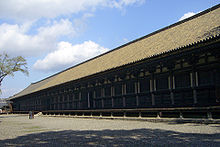Sanjūsangen-dō
The Sanjūsangen-dō ( Japanese三十 三 間 堂) is a Buddhist temple in the Higashiyama district of Kyoto, near the train station . Its official name is Rengeō-in- hon-dō (蓮華 王 院 本 堂, dt. "Main hall of the Temple of the Lotus King"). The popular name Sanjūsangendō refers to the 33 niches in the hall. The number 33 also embodies the 33 forms that Kannon can take.
The temple belongs to the temple Myōhō-in (妙 法院) and is also maintained by this. He belongs to the Tendai-shū , a school of Buddhism in Japan .
history
The temple was completed in 1164 under Taira no Kiyomori by order of Go-Shirakawa - tennō . He fell victim to a fire in 1249. Only the main hall was rebuilt in 1266. Today it is the longest timber structure in Japan.
In 1604 a famous duel between sword masters Miyamoto Musashi and Yoshioka Denshichiro took place here. This will u. a. Themed in the film Samurai II - Duel at Ichijoji temple (1955) by Hiroshi Inagaki and with Toshirō Mifune .
architecture
Mainly Bodhisattva Sahasrabhuja-arya-avalokiteśvara or the "Thousand-armed Kannon " is venerated in the temple . Its statue was created in the Kamakura period by the sculptor Tankei and, along with the main hall, is one of the national treasures of Japan . On both sides of the large Kannon statue, 1,001 life-size statues of the thousand-armed Kannon, each with different details, are placed in a regular row of 10 by 50 statues.
124 of these statues still come from the original temple, the rest were made in the 13th century. They are made from Japanese cypress and completely gold-plated. In front of the Kannon statues are 28 guardian figures and two famous statues of Fūjin (deity of wind) and Raijin (deity of thunder), which are also national treasures.
The statues stand on a pedestal that rises in 10 steps towards the rear; There is a small exhibition in the part of the hall that remains behind the podium.
In the courtyard is a simple stone monument that was erected by the Tendai priest Hōnen on the 13th anniversary of the death of Go-Shirakawa-tennō.
Events
In January, the rite of the willow (柳枝 の お 加 持) takes place in the temple , during which the believers are touched on the head with a holy branch of willow to relieve and prevent headaches.
The temple is famous from history for its as Tōshiya (通 し 矢, lit. "arrows that hit the target") known competitions in archery with the Japanese longbow. These took place annually in May on the 2.5 m wide, only 5.5 m high and 120 m long west veranda at the back of the temple. The shooters fired from the south end of the veranda at a cloth attached as a target on the north side, this was also where the judges' committee was located, which indicated the valid hits.
There were competitions over 100 arrows or 1,000 arrows as well as competitions over half the distance and the full length of the veranda (118 m shooting distance). In the latter case, a single archer had to target as many arrows as possible within 24 hours. This competition lasted from 6 o'clock in the evening one day until the evening of the next day. At night the porch was lit by several fires in front of the temple, which were guarded by fire fighters. The shooter took a short break every 500 hits and was rewarded with cheers from the audience.
This competition, which was held for the first time in 1606, was considered to be extremely demanding because, in addition to the stresses caused by the long duration of the competition, the low veranda forced a very flat trajectory and therefore the use of strong bows and a special shooting technique.
The record holder of all time is Wasa Daihachiro, then 22, in 1686 with 13,053 arrows, 8,133 of which reached their target. Mathematically, this results in an unbelievable rate of fire of approx. 9 arrows / min., In which, however, the tea breaks after 500 shots are not yet calculated. Second place went to the samurai Hoshino (10,542 arrows, 8,000 hits).
Even today, a well-known kyūdō competition is held every year on the temple grounds under the same name , but for monument protection reasons in the courtyard next to the main hall and only over 60 m away (“Enteki”). A demonstration of the Tōshiya in its original form takes place annually in mid-January.
swell
- Information boards in the temple
- F. Hoff: "Kyudo. The Art of Japanese Archery", 6th edition, Weinmann: Berlin 1996
Web links
Coordinates: 34 ° 59 ′ 15.88 " N , 135 ° 46 ′ 18.75" E




